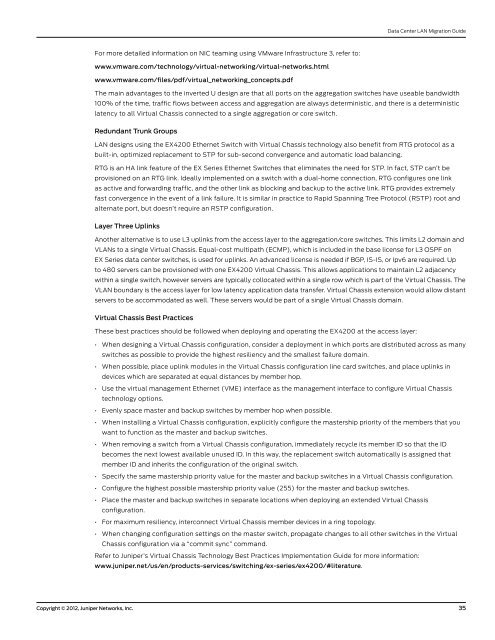Data Center LAN Migration Guide - Juniper Networks
Data Center LAN Migration Guide - Juniper Networks
Data Center LAN Migration Guide - Juniper Networks
Create successful ePaper yourself
Turn your PDF publications into a flip-book with our unique Google optimized e-Paper software.
For more detailed information on NIC teaming using VMware Infrastructure 3, refer to:<br />
www.vmware.com/technology/virtual-networking/virtual-networks.html<br />
www.vmware.com/files/pdf/virtual_networking_concepts.pdf<br />
<strong>Data</strong> <strong>Center</strong> <strong>LAN</strong> <strong>Migration</strong> <strong>Guide</strong><br />
The main advantages to the inverted U design are that all ports on the aggregation switches have useable bandwidth<br />
100% of the time, traffic flows between access and aggregation are always deterministic, and there is a deterministic<br />
latency to all Virtual Chassis connected to a single aggregation or core switch.<br />
Redundant Trunk Groups<br />
<strong>LAN</strong> designs using the EX4200 Ethernet Switch with Virtual Chassis technology also benefit from RTG protocol as a<br />
built-in, optimized replacement to STP for sub-second convergence and automatic load balancing.<br />
RTG is an HA link feature of the EX Series Ethernet Switches that eliminates the need for STP. In fact, STP can’t be<br />
provisioned on an RTG link. Ideally implemented on a switch with a dual-home connection, RTG configures one link<br />
as active and forwarding traffic, and the other link as blocking and backup to the active link. RTG provides extremely<br />
fast convergence in the event of a link failure. It is similar in practice to Rapid Spanning Tree Protocol (RSTP) root and<br />
alternate port, but doesn’t require an RSTP configuration.<br />
Layer Three Uplinks<br />
Another alternative is to use L3 uplinks from the access layer to the aggregation/core switches. This limits L2 domain and<br />
V<strong>LAN</strong>s to a single Virtual Chassis. Equal-cost multipath (ECMP), which is included in the base license for L3 OSPF on<br />
EX Series data center switches, is used for uplinks. An advanced license is needed if BGP, IS-IS, or Ipv6 are required. Up<br />
to 480 servers can be provisioned with one EX4200 Virtual Chassis. This allows applications to maintain L2 adjacency<br />
within a single switch, however servers are typically collocated within a single row which is part of the Virtual Chassis. The<br />
V<strong>LAN</strong> boundary is the access layer for low latency application data transfer. Virtual Chassis extension would allow distant<br />
servers to be accommodated as well. These servers would be part of a single Virtual Chassis domain.<br />
Virtual Chassis Best Practices<br />
These best practices should be followed when deploying and operating the EX4200 at the access layer:<br />
• When designing a Virtual Chassis configuration, consider a deployment in which ports are distributed across as many<br />
switches as possible to provide the highest resiliency and the smallest failure domain.<br />
• When possible, place uplink modules in the Virtual Chassis configuration line card switches, and place uplinks in<br />
devices which are separated at equal distances by member hop.<br />
• Use the virtual management Ethernet (VME) interface as the management interface to configure Virtual Chassis<br />
technology options.<br />
• Evenly space master and backup switches by member hop when possible.<br />
• When installing a Virtual Chassis configuration, explicitly configure the mastership priority of the members that you<br />
want to function as the master and backup switches.<br />
• When removing a switch from a Virtual Chassis configuration, immediately recycle its member ID so that the ID<br />
becomes the next lowest available unused ID. In this way, the replacement switch automatically is assigned that<br />
member ID and inherits the configuration of the original switch.<br />
• Specify the same mastership priority value for the master and backup switches in a Virtual Chassis configuration.<br />
• Configure the highest possible mastership priority value (255) for the master and backup switches.<br />
• Place the master and backup switches in separate locations when deploying an extended Virtual Chassis<br />
configuration.<br />
• For maximum resiliency, interconnect Virtual Chassis member devices in a ring topology.<br />
• When changing configuration settings on the master switch, propagate changes to all other switches in the Virtual<br />
Chassis configuration via a “commit sync” command.<br />
Refer to <strong>Juniper</strong>’s Virtual Chassis Technology Best Practices Implementation <strong>Guide</strong> for more information:<br />
www.juniper.net/us/en/products-services/switching/ex-series/ex4200/#literature.<br />
Copyright © 2012, <strong>Juniper</strong> <strong>Networks</strong>, Inc. 35

















